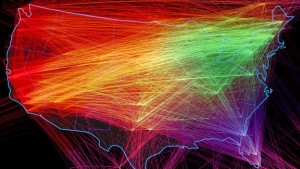Slang and How it Spreads
Sources:
Articles:
http://blog.hubspot.com/marketing/how-internet-changes-language
http://grammar.yourdictionary.com/slang/history-of-american-slang-words.html
https://www.newscientist.com/article/mg21628916.300-twitter-shows-language-evolves-in-cities/
http://www.newsweek.com/2015/03/27/meet-chicago-teen-behind-fleek-311031.html
Eisenstein Paper:
http://arxiv.org/pdf/1210.5268v4.pdf
Slang is not a modern phenomena, but an occurrence that has been prevalent throughout nearly all of human history and across all languages. For instance, the word “dude” first appeared in the English language as early as the 1870s! There is no doubt however, that the rise of the internet has had a tremendous role in allowing faster and more far-reaching spread of slang in the modern era. Additionally, the internet provides researchers with a record of data allowing systematic studies to determine how slang spreads throughout a social network. Such investigations were much more difficult, if not impossible to conduct when slang spread orally alone. The origin and diffusion of slang is interesting from a linguistic standpoint–evolutionary linguists spend their careers studying the way in which languages change over time, and slang is a highly important mechanism by which language quickly changes. From a networks standpoint, slang sheds light on the structure of social networks and the large network of the global internet.
Jacob Eisenstein, a Professor in the School of Interactive Computing at the Georgia Institute of Technology and the leader of Georgia Tech’s Computational Linguistics Laboratory, conducted a study to investigate the spread of slang between cities on the social media platform, Twitter. The study used a total of 107 million tweets within the time span from December of 2009 to May of 2011 and sent from wide-ranging locations within the United States. Using this gathered data, Professor Eisenstein’s research team modeled the pathways through which slang spread from city to city, employing a mathematical model called a “latent vector autoregressive model.” An interesting finding of this study was that new words were more often shared between cities that are demographically similar (economically and ethnically) as opposed to cities with geographic proximity. In the words of John Nerbonne of the University of Groningen, “birds of a feather tweet together.” A paper describing these findings, titled “Diffusion of Lexical Change in Social Media,” was published in 2014.
In terms of the topics discussed in class, this phenomena sheds light on the parameters by which we can define “strong” ties as opposed to “weak” ties. While novel information most frequently arrives at a node by means of that node’s weak ties rather than its strong ties, I argue that slang is more likely to spread via strong ties. As slang is considered a more informal form of language, people are more likely to use it while talking with close friends rather than with their acquaintances. I argue, then, that economic and ethnic similarities play a large role sociologically in forming strong ties, the edges along which novel slang most readily flows.
The above image depicts a visual representation of the spread of slang. The network is color-coded based on the region of the United States in which the slang first originated.
An interesting example that has recently attracted a large amount of attention on social media is the spread of the term “on fleek,” used most often to describe one’s eyebrows as “on-point” or attractive. While the term itself existed in the early 2000s, the slang only became popular this past year when Peaches Monroee posted a video on Vine in which she described her eyebrows using the term. The video subsequently went viral, and the term was quickly used widely, including by celebrities such as Ariana Grande as well as companies such as Taco Bell. I have not encountered any scholarly articles describing research conducted on this particular case–it is perhaps much too early for such work to have been published. Still, this is an interesting case study which can be used to understand the way in which slang spreads. The intensely viral nature of the video perhaps allowed the spread of this phrase to rapidly transcend the economic and ethnic barriers prevalent in the data analyzed by Eisenstein’s group. Detailed analysis of the spread of this particular term could shed new light on the diffusion of slang in the context of viral media. Perhaps most importantly, by inspiring an outpouring of articles and even a Buzzfeed video, this case has pushed Americans to think more deeply about the spread of slang via the internet.

